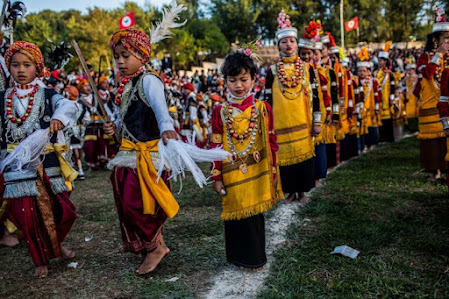Ryndia (Eri silk) of the Khasi Hills- An inherited Art.
Meghalaya produces three out of the four varieties of silk available in the world. They are – Eri; locally known as Ryndia, Muga and Mulberry. Eri Silkworms are reared and is woven traditionally by weavers in the Khasi hills. The practice shows yarn spun from Eri cocoons, and dyed into various colors using natural, organic vegetative dyes. The Eri cocoons produced by the silkworm (Philosomia Ricini) are also reared by most of the people in rural areas of the North Eastern states of India. With its rustic look, Eri silk has good thermal properties and has been certified as eco-friendly. Eri silk production is an old aged small scale industry, which provides livelihood to families in the regions. It is a traditional Art inherited from generation to generation and treated as an occupation.
THE REARING PROCESS OF ERI SILKWORMS(Philosomia Ricini).
Season: Rearing can be done throughout the year. However, March-April and September-October are the best seasons for silkworm rearing.
Egg Incubation:The silkworm eggs are laid out on paper and are cooled. They are incubated at 24-26°C and 75-85% relative humidity.
Brushing: Brushing off newly hatched worms on tender leaves (preferably castor) to start the feeding process preferably, during morning hours.
The third stage: The silkworms are transported to Kriahs or flat woven baskets laid with news papers. The silkworms are then given Kesseru leaves to feed upon.
The fourth Stage: On the fourth stage the Kesseru leaves are replaced with Payam leaves. In this stage we notice the silkworms growing bigger in size.
Ripe worm collection: Ripe worms become yellowish-white and start roaming for selection of site for cocoon formation. Mature worms are collected and put to cocooning mountages.
PROCESSING AND SPINNING OF ERI SILK COCOONS.
Visit: Weaving cluster, Umden village, Meghalaya.
The Eri cocoons produces filaments that are discontinuous. Hence, eri cocoon can only be used for spinning purpose. Major portion of eri cocoons produced in the region is locally hand spun and sometimes mill spun.
Drying: Sun drying is practiced because of its simplicity. Shell drying is necessary for preservation and storage.
Cocoon selection: Clean, dry and uniform quality cocoons are choosen for spinning.
Degumming: The cocoons are boiled for 45 minutes to 1 hour. After boiling, individual cocoons are stretched into thin sheets. Locally available materials such as ash obtained from banana, wheat stalk, paddy straw and pieces of green papaya are commonly used as degumming agent. The eri cocoons are then hand spun or at times, spun by hand.
ORGANIC DYES.
The natural colour of Eri Silk varies from white to very light cream or light grey. Color and shade depend upon a number of factors such as quality of the worms, their feed, temperature and climate. The difference in shade is more distinguishable in men’s shawls because they are seldom dyed into other colors (in the region). In women’s apparels, however, the shades get camouflaged after dyeing. The dyes that master dyers use are always natural, which are generated majorly from plant parts – leaves, fruits, flowers, barks or roots. Iron ore is also used to obtain black color.
- Lac (Laha) red
- Turmeric yellow
- Black from iron ore.
Today, with trainings and workshops; the artisans have increased their repertoire of colors by experimenting with all kinds of leaves, flowers, roots and fruits from around the region. The colors they create depend on the season and the availability of these natural resources locally.
DYEING PROCESS- LAC (Laha).
Visit: Weaving clusters, Diwon village, Meghalaya.
- The lac is pounded until it becomes moist.
- Hot water is poured and mixed thoroughly until the Lac becomes sticky.
- The paste is then filtered with the help of a cloth and basket.
- The threads are soaked in water.
- The lac paste is mixed with water and boiled.
- Sohkhew leaves (local fixant) are cut into small pieces and added to the dye.
- The threads are soaked in the mixture and stirred well.
- It is left to boil for about 1-2 hours until the mixture becomes thick and the level decreases.
- The threads are then taken out rinsed mildly with soap and left to dry in the
shade








Excellent blog post Kudos to you
ReplyDeleteVery good Information. Will be useful for educational references.
ReplyDeleteThanks a Lot!
Delete